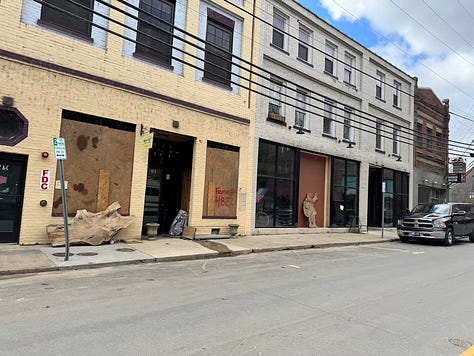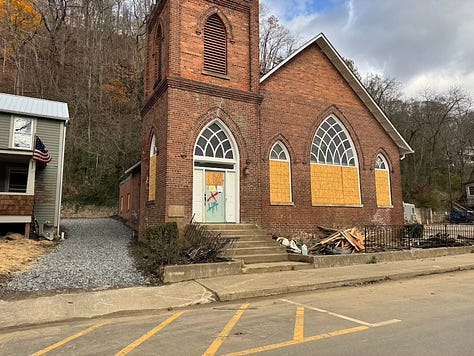The Marshall Plan
After the devastation of Hurricane Helene, the town of Marshall, North Carolina, stands at a crossroads. Imagine adopting this beleaguered town and applying innovative ways to ensure its renaissance.
“Let us take you to Marshall,” my mother said. “You’ll see how lucky some of us are.”
Marshall, NC, is only about fifteen minutes from my mother’s little farm in Weaverville. Mercifully, Weaverville was spared. Marshall was not. Only the latter’s bones and some of its doggedly determined inhabitants remain.
Two years ago, my wife and I drank coffee in Marshall as we considered relocating there. We dodged a biblical flood.
Though thoroughly battered, Marshall’s infrastructure and resilient mountain population offer the basis for an ambitious recovery effort.
The Plan
With the following plan, I sketch out a set of strategies to rebuild Marshall and transform it into a model for resilience, economic growth, and community revitalization.
With this plan, I will try to balance the novelty required to make Marshall whole again and the traditions and culture that made it special to begin with. While its denizens will never be able to have the Old Marshall back just as it was, hopefully, the New Marshall can retain much of its rich cultural DNA and, vitally, its people.
1. “Acts of God” Mutual Aid Society Fund
Marshall’s recovery will benefit from the townspeople sticking around. That means the people will need a significant infusion of triage resources from regional and national funds established for this adopted town. These funds can be organized into a self-administered mutual aid society, for example, under a 501(c)14 organization. Such will provide some of the financial stability needed for immediate recovery efforts and charity assistance to the townspeople.
2. Accelerated Coordination and Cleanup Fund
A dedicated fund to expedite cleanup operations and coordination among local, state, and federal agencies. This initiative will streamline the removal of debris, restoration of critical infrastructure, and re-establishment of essential services, ensuring the town can recover rapidly and efficiently. (Could be coupled with #1.)
3. Federal and State Tax-Free Zone (15 Years)
To invite investment and attract businesses, old and new, Marshall would be designated as a tax-free zone (federal and state) for 15 years. This will encourage entrepreneurship, industry relocation, and long-term economic growth while reducing barriers for enterprises to set up operations in the town.
4. Philanthropists’ Club
The Blue Ridge Mountains have always drawn the wealthy, particularly from Florida. Instead of continuing to build gated communities with their own, wealthy philanthropists could pool their resources to start a high-profile initiative to aid in Marshall’s recovery while enjoying the town’s renaissance. Members can build an exclusive club there with adjacent luxury residences or properties in Marshall—perhaps with a portion of any proceeds to be reinvested in town redevelopment projects. Such could bring visibility, capital, and employment opportunities.
5. Marshall Crowd Fund
Imagine a grassroots crowdfunding initiative that invites individuals, families, and small investors to participate in Marshall’s recovery. This fund would offer tiered investment opportunities—ranging from micro-loans to equity stakes in redevelopment projects—ensuring a broad base of contributors with a personal stake in the town’s revival. The Crowd Fund would use Alex Tabarrok’s Dominant Assurance Contracts to allocate the investment funds, with each participant enjoying a proportional amount of any returns. Gifts and proceeds could also be returned to the resource pool for future private provision of public goods.
6. Development at Cost Plus 10%
Construction and infrastructure rebuilding will operate under a cost-plus-10% pricing model, ensuring developers are fairly compensated, but any profit over 10% would go into #s 1 and 2. This transparent and efficient approach guarantees value for the town and keeps redevelopment priorities aligned with community priorities. This would be a mission-based project for highly successful developers.
7. Corporate Adoption
Major corporations will be invited to adopt Marshall and launch projects as part of their corporate giving programs. These initiatives could include building public spaces, sponsoring schools, or investing in infrastructure, leaving a lasting legacy in the community. For example: Toyota USA proudly adopts Marshall and will include it in its giving for x years. Such could align with 1 and 2 regarding funding sources, or the corporation could provide free or discounted products.
8. Sister City Adoption
For example, Marshall could forge a sister-city relationship with a community in the Netherlands. Renowned for its water management and flood resilience expertise, Dutch engineers and urban planners could provide consulting services to protect Marshall from future natural disasters, sharing knowledge, proven solutions, and the cultural exchanges of traditional sister-city programs.
9. Sandy Springs, GA, Governance Model
Marshall will adopt a governance model inspired by Sandy Springs, Georgia, which operates with a privatized approach to municipal services.
Council-Manager Government: Sandy Springs, GA, operates under a council-manager system where an elected mayor and town council set policy, but a city manager oversees daily operations.
Privatized Services: The city uses an innovative public-private partnership model, contracting out most municipal services to private companies that compete for the business, which lowers costs and raises quality.
Mayor Leadership: The mayor, elected at-large, serves as the city's ceremonial head and provides leadership for the council.
City Council Representation: The city council comprises members elected by districts, focusing on legislative functions and community needs.
Citizen Engagement: Governance emphasizes transparency and public involvement, including opportunities for residents to participate in decision-making.
This structure will ensure cost-effective service delivery and nimble governance during the critical recovery period. (And if it works, why not keep it?)
10. Business Site Auctions
Owners of vacant or underutilized commercial sites can auction them off to entrepreneurs and developers. This competitive process will attract new investors and entrepreneurs and ensure rapid redevelopment of key areas.
With a blend of innovative financing, public-private partnerships, and strategic expertise, the town can become a beacon of hope and a model for disaster recovery worldwide.
Photos of Marshall













Turns out it only works via email.
I have something that fits with the marshall plan
A mind map of a 12 year philanthropic bond to heal the riparian way along the hurricane ravaged Swannanoa
https://visualmind.app/mindmap/642bd36a-e26d-4dc6-b906-4e18cdd8e468